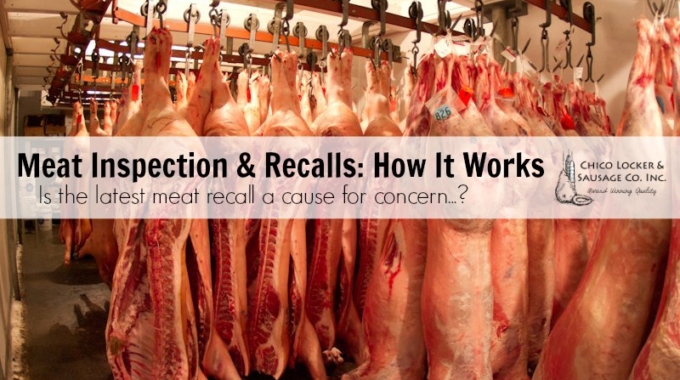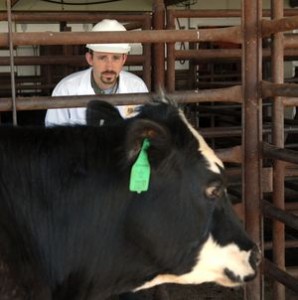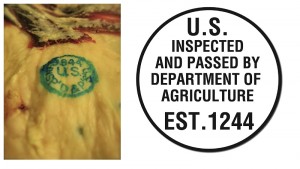
Latest Recall: Cause for Alarm?
I am sure by now you all have heard about USDA recalling nearly 9 million pounds of meat processed through Rancho Feeding Corporation in Petaluma, CA. The news media has been releasing USDA’s press release regarding the recall and quite frankly, unless you speak meat jargon, it sounds pretty dang scary. It talks about the meat being classified under a class I recall which means it “involves a health hazard where a reasonable probability exists that eating the food would cause serious, adverse health consequences or death.” Sounds pretty serious right?
It very well could be. Or it couldn’t be. Not nearly enough information has been released on the recall to make speculations OR judgments on what happened in order to have a massive recall of a year’s worth of production. I have seen the rumors flying about how terrible places like this are (ie: “Big Ag”) and I have seen people standing up for the company saying there is no way their processing facilities could be under par. Whatever the reason for the recall, it’s important to understand WHAT a recall is, HOW inspection works, and WHY a recall is effective in order to take the fear out of it all.
What is Federal Inspection?
Recalls happen on meat that is slaughtered and processed under “federal inspection”. Some people get confused about the classifications of inspection. There is federal inspection and there is state inspection. Federal inspection is run and maintained by FSIS. USDA changed its’ meat, poultry, and egg inspection branch to FSIS (or Food Safety Inspection Service) several years ago and has caused some confusion for people since then. These two entities are the same thing. FSIS is simply a facet of USDA that is responsible for “ensuring the nation’s supply of meat,  poultry, and eggs is safe, wholesome, and correctly labeled and packaged”. Meat processed under federal inspection can be re-sold anywhere.
poultry, and eggs is safe, wholesome, and correctly labeled and packaged”. Meat processed under federal inspection can be re-sold anywhere.
Federal inspection is the ONLY classification where meat can be re-sold once it leaves the butcher shop. It can be wholesale, sold to restaurants, or put in a retail meat case. Federal inspection is the most stringent classification of inspection and is the most regulated. When meat is evaluated for safety and wholesomeness, it either passes and enters the market for human consumption or it fails and cannot be sold. There is no middle ground.
The duties of a federal meat inspector are as follows:
- Detection and destruction of diseased meat and/or contaminated meat
- Assurance of clean and sanitary handling and preparation
- Minimization of microbiological contamination of meat
- Prevention of adulteration (the addition of harmful substances) and the presence of chemical or drug residues
- Prevention of false labeling
- Application of inspection insignia (USDA stamp/seal)
Federal inspection requires MANY steps of paperwork to go along with all of these duties. It’s not just simply that the inspector does his duties and there is nobody there to check his work. Paperwork is how FSIS ensures the inspector is doing his job and report that the plant is meeting the standards set by FSIS. He has to sign off on forms designed for each duty, which are then submitted to his boss and so on. If there is a problem with the paperwork, that can be a reason for a recall but we will get into that later.
How Does Federal Inspection Play Out in a Slaughterhouse?
Depending on how large the slaughterhouse is, you could have one inspector or you could have a dozen or more. The more animals you are running through a day, the more inspectors you will have on hand and the more eyes each and every carcass will pass by. Inspection is done at set hours during the day and all slaughter activities must be done while the inspector(s) are present. Animals slaughtered not under inspection are automatically assumed to be “diseased and unsound” in the eyes of the FSIS even if the meat is perfectly fine to consume and poses no health risks.
The entire inspection process begins outside the slaughterhouse. Even before the animals can step foot into the slaughterhouse they must be documented for their place of origin (especially beef). It doesn’t matter if the animal came from a feedlot, dairy, or private individual, there has to be a document of origin submitted which the FSIS inspector reviews and signs off on it.
 Once the origin of the animals is approved, the inspector must conduct an ante-mortem (or prior to slaughter) inspection of the animals live. During this inspection, the inspector is looking for any signs of illness, disease, BSE (bovine spongiform encepholathopy or Mad Cow Disease), abnormal growths, ensuring the animal is structurally sound (it is not crippled and can get up and walk), and other red flags that could potentially be a danger to the food supply. Animals who cannot get up and walk are known in the industry as “downers” and cannot be processed for human consumption.
Once the origin of the animals is approved, the inspector must conduct an ante-mortem (or prior to slaughter) inspection of the animals live. During this inspection, the inspector is looking for any signs of illness, disease, BSE (bovine spongiform encepholathopy or Mad Cow Disease), abnormal growths, ensuring the animal is structurally sound (it is not crippled and can get up and walk), and other red flags that could potentially be a danger to the food supply. Animals who cannot get up and walk are known in the industry as “downers” and cannot be processed for human consumption.
The inspector marks the animals as passed, suspect, or condemned. Animals that are marked as suspect are held for a time and then re-evaluated before they can be passed. If the animal cannot pass, it is condemned and cannot be slaughtered for human consumption. The entire animal (head, internal organs, etc.) cannot be used, is documented, and must be disposed of under the supervision of the inspector. Once the inspector has deemed the animals have proper origin paperwork AND are fit and healthy for slaughter, the animals are allowed to be brought into the slaughterhouse.
Animals are brought in and the inspector ensures the animals are humanely stunned (whether it be through using a captive bolt or some other humane method). It is federal law that the animals be stunned and rendered insensitive to pain before the animal is bled. Once the animal is stunned and bled, it goes through the rest of the slaughter process.
FSIS inspector(s) observe the entire process and look at the entire carcass and all of its parts (also called a post-mortem inspection). The inspectors take a close look at things like the head, lymph nodes, and internal organs (like heart and liver) to look for signs of disease or other contamination. If there is something the inspector doesn’t like such a bruise or abscess on the carcass or any part of the animal, the inspector can ask an employee to remove it OR the inspector can do it him/herself.
 Once the slaughter process is complete, the inspector will declare each carcass as either pass, retain, or condemn. Carcasses that are retained for things like random testing for E. Coli, etc. will be held until they until the tests come back and then depending on the results, are either sent back into production or condemned. If a carcass is condemned, they are deemed inedible and are removed completely from the food supply. Animals that are passed are then stamped with the USDA seal of inspection. These stamps are kept under lock and key until the inspector is ready to use them. None of the plant owners or the employees has access to these stamps. In order for the meat to enter food production, it must be stamped with the seal, which signifies that the animal was slaughtered under inspection.
Once the slaughter process is complete, the inspector will declare each carcass as either pass, retain, or condemn. Carcasses that are retained for things like random testing for E. Coli, etc. will be held until they until the tests come back and then depending on the results, are either sent back into production or condemned. If a carcass is condemned, they are deemed inedible and are removed completely from the food supply. Animals that are passed are then stamped with the USDA seal of inspection. These stamps are kept under lock and key until the inspector is ready to use them. None of the plant owners or the employees has access to these stamps. In order for the meat to enter food production, it must be stamped with the seal, which signifies that the animal was slaughtered under inspection.
This is just one small portion of inspection, once the carcasses go onto further processing; there is a whole other set of events and more regulations to be met. But that is for a whole other post. Back to recalls…
So how does a recall happen?
Recalls happen for a variety of reasons.
- cross contamination :allergens, non-inspected meat touched inspected meat, etc.
- bacterial contamination: usually picked up by the random sampling done in the slaughterhouses and further processing facilities
- unsanitary conditions: part of facility isn’t clean, workers hygiene is poor, etc.
- problem in inspection: incorrect paperwork, the inspector wasn’t doing his/her job correctly, problem with ante-mortem inspection
Currently for 2014, there have been 13 active recalls for the year, each one having to do with one of the reasons above. Out of the 13, nine for the year have been class I recalls meaning “involves a health hazard where a reasonable probability exists that eating the food would cause serious, adverse health consequences or death.” The key word is “reasonable probability”. In the case of our latest recall, just because USDA puts out a press release saying the meat has a probability to be diseased DOES NOT mean it IS diseased. It means that the meat was not properly inspected, so the probability is there. USDA has to assume that all of the meat not properly inspected IS infected. It’s either all or nothing.
If one of the steps laid out above is missed or any part of them aren’t done correctly, that animal is considered unfit. It does not matter if the animal is perfectly edible, the carcass is automatically considered a risk and cannot enter the food system. Depending on the situation, often times, particular carcasses can be isolated and destroyed, but if a particular carcass cannot be identified, EVERY SINGLE ANIMAL that was slaughtered that day is deemed at risk and must be disposed of. If the processing facility does not follow guidelines or USDA learns of a problem in inspection, it can trigger a recall.
So let’s go back to Rancho Feeding Corp. and their 8.7 million pound recall. I cannot say WHY the recall happened, but it is apparent that something was going for USDA to deem the animals to be butchered under “not full inspection” for an entire year. This means the vast majority of the meat processed through that plant was probably already consumed and ZERO illnesses have been reported. 8.7 million pounds of meat sounds like a big number, but when you break it down, it only equates to maybe 100-200 cattle a day. Compare this to a plant like Cargill which produces 8 BILLION pounds of meat per year and are running somewhere near 1,500 head of cattle through their slaughter facility a day and Rancho Feeding Corp in the scheme of things is actually a pretty small, local slaughterhouse. Regardless of why the recall happened, it is absolutely apparent that if the slaughterhouse closes down over this, the local Bay Area farmers and dairies will be out of places to take their animals to be processed.
In the end, a recall is like a system of check and balance. It shows that the system of inspection is working. A recall allows the ability to find and correct a mistake and often times can be diagnosed before the meat reaches the general public. But that is not always the case, sometimes a recall happens long after the fact and Rancho Feeding Corp is a prime example for that. The important thing to take away here is that a recall doesn’t necessarily mean a cause for serious alarm. Sure, recalls are a big deal and it is important to keep an eye out for them. But even the biggest recall may end up being not at all as scary as it sounds in the news.
One of the best ways to ensure food safety is at home. Inspecting your food when you purchase it, storing and handling it properly, and cooking meats to proper internal temperatures are all steps you can be in control of at home to prevent food born illnesses.
For more information on food safety, visit this link. If you are interested in more information about inspection and recalls, visit these resources:
- Another Beef Recall
- Understanding Recall Concept in Food Industry
- Meat Inspection
- Meat Inspection and Grading
- Meat Inspection: Pass or Fail



